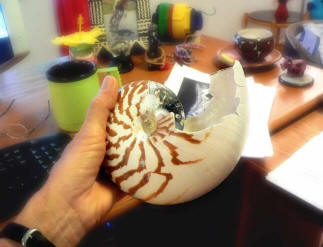Published in the Ocean Watch column, Honolulu Star-Advertiser © Susan Scott
April 13, 2007
Years ago, I stopped collecting empty seashells, because I thought they were better off in the ocean or at the shore. If hermit crabs didn’t adopt them for homes, then the ocean could gradually take back its calcium carbonate. Also, admiring a shell and then returning it to a beach or reef gives other people a chance to enjoy its beauty.
In theory. In truth, when the ocean lays a treasure at my feet, it’s hard to just say no. I see the shell, pick it up, marvel at its texture, shape and colors, and then, whoops, there it goes into my pocket.
The shells that bring out my strongest hoarding urge are the ones with mother-of-pearl interiors. Mother-of-pearl is well named since this is the substance that surrounds irritants in oysters and creates pearls.
Pearls are pretty, but whether they’re natural or cultured, to me they’re still tumors. One of my favorite pearl quotes is by H. Martyn Hart in “The World of the Sea” (1869): “It is a singular reflection that the gem so admired and coveted by man should be the product of disease in a helpless mollusk.”
In Tahiti last year, I bought some black oyster tumors for necklace gifts. But while there, I was equally thrilled to find giant shimmering oyster shells lying on the ocean floor. (Yes, I kept one.)
Even better mother-of-pearl manufacturers are the abalones.
We warm-water residents don’t know much about abalone, because they grow in cold water, using a strong muscular foot to cling like opihi (limpets) to rocks. Each of these marine snails bears one oval, bowl-shaped shell with a row of holes along one side. Because abalone feet are edible, people harvest wild abalone and also cultivate them in aquafarms.
Abalone mother-of-pearl comes in a luminous mix of blues and greens with swirls of pink, silver, gold, orange, purple and lavender. People use this striking material in buttons, as furniture inlays, to adorn musical instruments and, of course, to make jewelry.
I make a point of not buying jewelry made of marine shells, but abalone is an exception. I’m happy to recycle the discarded shells of a food product. And not only is abalone shell jewelry beautiful, it’s cheap. I’m wearing a fine pair of abalone shell earrings I bought in Australia last week for $3.50.
Like oysters, abalones also form pearls in response to a foreign body. Abalone pearls, however, are rarely round. Natural ones look more like an eye tooth, so shaped because they are often formed inside the tapered tip of the animal’s gonad.
When a boring bivalve invades an abalone from the outside, the abalone mother-of-pearl grows around it, creating what’s called a blister pearl. Blister pearls remain embedded in their shells. (Oysters make blister pearls, too.)
Archeological sites in California suggest that people used abalone pearls for trade more than 7,000 years ago, and in the early 20th century, they were popular as jewelry. The largest one in the world is called Big Pink and weights 3.3 ounces.
OK, when it comes to collecting shells from beaches, I’ve not totally stopped. When the ocean lays a huge, nearly perfect chambered nautilus shell at my feet, which happened recently, who could refuse such a gift? Not me. It now sits on my desk.
